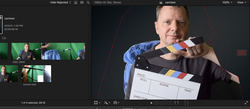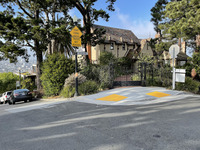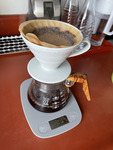 |
| Angelika/Mike Schilli |
|
Audio and video are thus separate, and your main actor often needs several attempts without too many "uhs" before getting it right, so it was worth investing in professional grade video editing software. I got the expensive and complicated Mac program "Final Cut Pro" at a discounted price directly from the factory. The program is very sophisticated, but at the same time so complicated to use that no normal person could make a 10-second video with it. Fortunately, there are thousands of videos on YouTube about how to use the hellish program without going crazy.
It is amazing, and hard to predict in advance, how well homemade videos on YouTube will be received. Despite the elaborate production, the presentation of my baking skills is still languishing in the two-digit views range, such as my video on baking pretzels>or the one on makinghttps://www.youtube.com/watch?v=3ylQG3ig0E0.
I've had much better success on Youtube with my car repair video, where I take apart the center console of our Honda Fit to retrieve Angelika's earring that had slipped down there. Interested hobby car mechanics have already viewed it three thousand times! (Figure 2).
By the way, I learned during my crash course to become a self-proclaimed video wizard why in professional film productions, there's always an assistant with a chalkboard that comes into the picture at the beginning of each scene, and loudly snaps a checkered bar on it, shouting "Scene One!". Turns out that the video and sound of a film are usually recorded separately and then patched together in post production. For my home videos, I often take the image of the cell phone camera or an SLR, whose microphones only produce tinny sound. At the same time, I have a studio microphone record the good sound and the laptop records this to a digital audio file.
Next, a movie editor must piece the film together so that the actor puckers his lips at exactly the moment the "o" sound is heard on the good audio track and there is no shift, as with a bad bootleg. This is an incredibly tedious task that you never quite get right by hand, but this is where the slate comes in: at the beginning of the film scene, the bar visually snaps on the slate and you hear the corresponding click sound on the audio track, also graphically represented as a spike in the editing software - and bam!, you can move both tracks so that the audio spike matches the image of the snapping bar. Everything else then matches up as with an Oscar-winning Hollywood production. Of course, I immediately bought a click slate on Amazon, it only cost 10 dollars. Funny enough, I only found out much later that the editing software "Final Cut Pro" can automatically synchronize a video track with bad audio with a separate audio track recorded by microphone. Times we live in, people!













